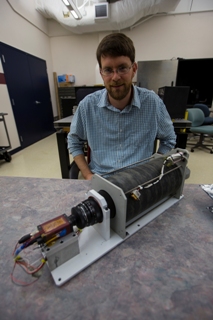Jan 29 2015
Scientists who use high-altitude scientific balloons have high hopes for their instruments in the future. Although the floating behemoths that carry their instruments far into the stratosphere can stay aloft for days on end, data collection typically happens during the night when starlight can be detected. The instruments that operate during the day are limited in their field of view due to overbearing sunlight.
 Wallops engineer Scott Heatwole and his team are developing a precision attitude sensor or star tracker that would be able to locate points of reference, or, in other words, stars, during daylight hours. Heatwole specifically developed the technology for the Wallops Arc Second Pointer. Image Credit: Patrick Black/NASA
Wallops engineer Scott Heatwole and his team are developing a precision attitude sensor or star tracker that would be able to locate points of reference, or, in other words, stars, during daylight hours. Heatwole specifically developed the technology for the Wallops Arc Second Pointer. Image Credit: Patrick Black/NASA
An engineer at NASA’s Wallops Flight Facility (WFF), located on Virginia’s Eastern Shore, is working on a low-cost, off-the-shelf solution to overcome the challenges of collecting data in daylight.
Under WFF’s Balloon Program, engineer Scott Heatwole and his team are developing a precision attitude sensor or star tracker that would be able to locate points of reference, or in other words, stars, during daylight hours. These points of reference serve as landmarks that help orient the instrument so that it can find the target of interest.
The star tracker is being developed specifically for the Wallops Arc Second Pointer (WASP), which would use the star tracker’s data to point a balloon-borne scientific payload with incredible accuracy and stability. Currently, WASP usually employs the commonly used ST5000 star tracker. However, this device cannot image in the daytime even at 120,000 feet where scientific balloons operate. Though relatively dark at those altitudes, the scattering of sunlight off the atmosphere can overwhelm the starlight in most star cameras.
“A precision attitude sensor capable of working in the daylight would extend science operations through the day which would significantly increase the amount of science collected,” Heatwole said. “Currently, the only precision attitude sensor available in daytime is a sun sensor, and this isn’t ideal because it provides only two axes of attitude and is not precise over a range of targets across the sky.”
Although others have developed custom star trackers that enable around-the-clock science gathering, no one has pulled together an inexpensive, ready-to-go package that includes cameras, computers, and the algorithms necessary to process data and eliminate excess visible light in real time. “That’s what we’re trying to do,” Heatwole said, adding that his daytime star tracker consists of a commercial firewire camera attached to a lens and baffle that help filter out visible light, allowing it to sense points of reference in the near-infrared wavelength bands.
In 2014, a prototype of the device flew on two WASP missions. The first, the flight of the HyperSpectral Imager for Climate Science (HySICS) collected radiance data as WASP pointed the instrument toward the Earth, the sun, and the Moon. The goal was to see what the star tracker saw at 120,000 feet.
The second WASP mission, launched a couple months later in October, carried the Observatory for Planetary Investigations from the Stratosphere (OPIS). Its mission was to gather time measurements of Jupiter’s atmospheric structure — a challenge for the new star tracker because the gas giant is a bright object.
“Our algorithm didn’t work as we had hoped,” Heatwole said, adding that it did not filter out the excess light as expected.
Heatwole, however, is unfazed. Over the coming months, he plans to fine-tune the algorithms to eliminate the extra light experienced during the OPIS mission and then retest the technology during a sounding rocket flight this summer and additional WASP missions in 2016 and 2017.
“We’re trying to increase the capabilities of WASP,” Heatwole explained. “No company is going to go out and build this. No one is going to develop an off-the-shelf, low-cost daytime star tracker and put all the components in one package. WASP requires an attitude sensor that is capable in the daytime. That’s what we hope to create.”